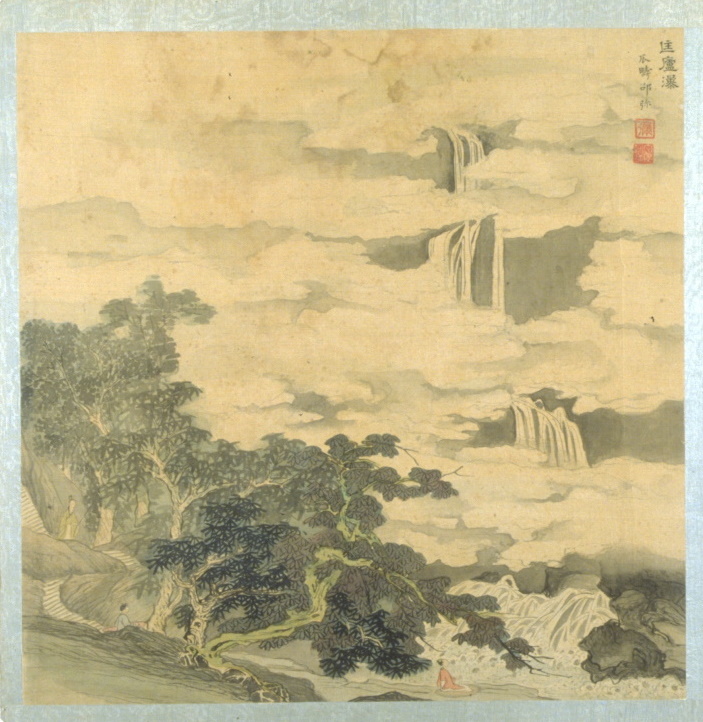
Shao Mi
Chinese, active 1620-1660
Viewing the Waterfall at Mount Lu
ca. 1620-1642, Ming dynasty
Ink and color on silk
On loan from the University of Michigan Museum of Art,
Margaret Watson Parker Art Collection Fund, 1966.1.92
Mount Lu, also known as Mount Guanglu, in modern Jiangxi province has long been a locus for spiritual activity with many Daoist and Buddhist temples, and Confucian landmarks constructed at the site. It also is celebrated for its beauty with natural caves, waterfalls, and towering peaks that rise to nearly 5000 feet. One of the famous views is a waterfall with a 500-foot drop at the foot of Wulao peak. It is called "Three-step Waterfall" because water falls over three terraces. This may be the place Shao Mi depicted, but he simply wrote "Waterfall on Mount Lu" in the upper right corner next to his signature and his two seals.
Shao Mi conveys the high altitude by masking the surface of the mountain in thick banks of clouds. Just off center, the waterfall appears between breaks in the clouds, and the steps in its descent are clear. At the lower right, water hits the rocks and then gathers in a pool. In the left corner, stepped paths among the trees provide access to the site. A person in red clothing already has found the perfect spot along a ledge, and another adult and child still are climbing the steps. Maybe the clouds will lift, and the travelers will have a full view, but in the meantime, even a glimpse of the mountain and waterfall is worth the journey.
Shao Mi was from a small town near Suzhou. He received an education in the classics, but chronic illness prevented him from taking exams for appointment to government service. It is unclear whether Shao Mi ever visited Mount Lu, but he would have known about this famous place and could have seen representations by other artists. This painting likely was part of a set of images, each paired with a leaf of calligraphy. Scholars disagree whether the current pairing is original or may have been mismatched during remounting. Even though the poem opposite the painting refers to a view from a different peak in the same range of mountains, it still captures the dream-like quality of the scene in the painting:
-
The Five-elder Peaks on the southeastern section of Mount Lu
Resemble golden hibiscus carved from the heavenly blue sky.
The elegant scenery of Jiujiang can be easily taken in,
I will nest here, among the clouds and pines
Bibliography
Cahill, James. The Distant Mountains: Chinese Painting of the Late Ming Dynasty. New York and Tokyo: Weatherhill, 1982.
Cahill, James. The Restless Landscape: Chinese Painting of the Late Ming Period. Berkeley: University of California, Berkeley, 1971. Exhibition catalogue.
Fu, Li-Tsui Flora. Framing Famous Mountains: Grand Tour and Mingshan Paintings in Sixteenth Century China. Hong Kong: The Chinese University Press, 2009.
Laing, Ellen Johnston. "Riverside by Liu Yuan-ch'i' and The Waterfall on Mt. K'uang-lu by Shao Mi." University of Michigan Museum of Art Bulletin 5 (1970-71), 1-13.
Laing, Ellen Johnston. "Shao Mi." Dictionary of Ming Biography 1368-1644. New York and London: Columbia University Press, 1976.
"Lushan National Park." World Heritage List, United Nations Educational, Scientific, and Cultural Organization Website. Accessed Nov. 20, 2021. https://whc.unesco.org/en/list/778/
Wu, Marshall. The Orchid Pavilion Gathering: Chinese Painting from the University of Michigan Museum of Art. 2 vols. Ann Arbor, MI: Regents of the University of Michigan, 2000. Exhibition catalogue.